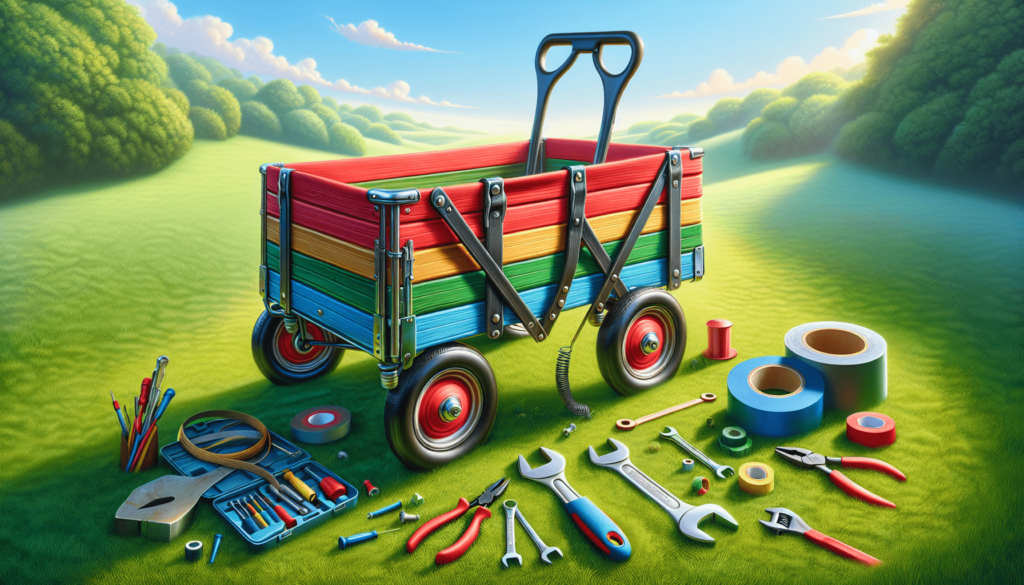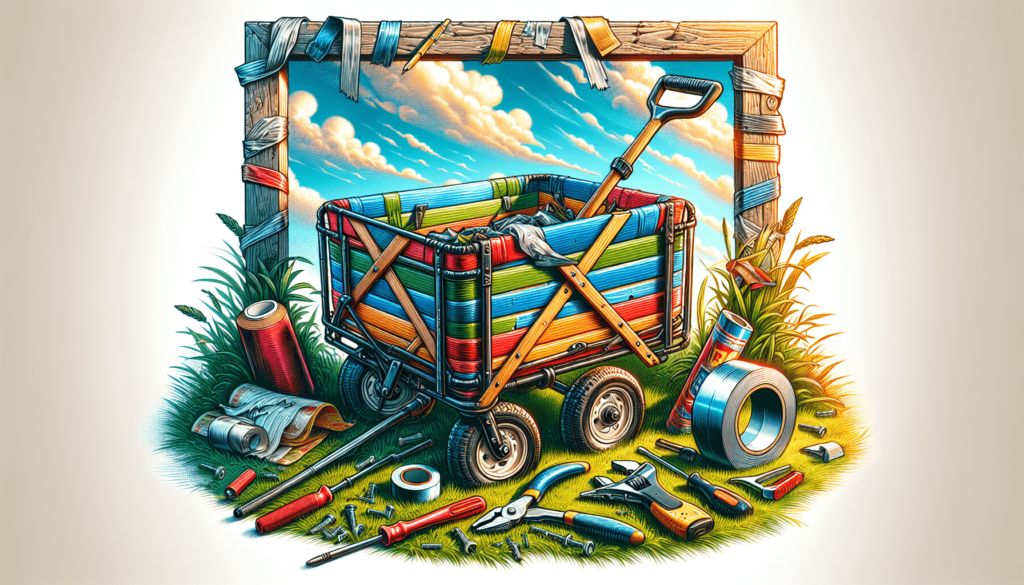Have you ever found yourself struggling with a folding wagon that just doesn’t want to cooperate? Whether it’s a stubborn wheel, a tricky folding mechanism, or something else entirely, these issues can be frustrating. But the good news is, many common folding wagon problems can be fixed with a little DIY spirit and a handful of basic tools.

Understanding Your Folding Wagon
Before you embark on any repairs or fixes, it’s crucial to get to know your folding wagon. Each model can vary in design and construction, but most share common components such as wheels, frames, and the folding mechanism itself. Reflect on how your wagon works when in good condition. Familiarizing yourself with its parts will make troubleshooting much easier later on.
Common Components
Understanding the basic components of your wagon can help clarify what might be wrong. Here’s a quick rundown of typical parts you might encounter:
| Component | Description |
|---|---|
| Frame | The support structure, usually made of metal or heavy-duty plastic. |
| Wheels | These allow the wagon to roll and typically consist of a hub and tire. |
| Folding Mechanism | The mechanism that enables the wagon to collapse for easy storage. |
| Fabric | Usually a canvas or nylon material that forms the body of the wagon. |
By familiarizing yourself with these components, you can better pinpoint any issues when they arise.

Common Folding Wagon Problems
Let’s get into the nitty-gritty of the most common issues you might encounter with your folding wagon. Each problem is often simple to diagnose and fix with a bit of initiative.
Sticking or Jammed Wheels
One of the more common issues with a folding wagon is having wheels that stick or jam. This can be super disappointing, especially when you’re on the move!
Why it Happens
- Debris Buildup: Small rocks, dirt, or other debris can get stuck in the wheel wells.
- Lack of Lubrication: Wheels need to be lubricated periodically to maintain optimal movement.
DIY Fixes
-
Clean the Wheels:
- Remove any visible debris from around the wheel and axle.
- Use a brush or cloth to get rid of any build-up.
-
Lubricate the Wheels:
- Apply a small amount of lubricant to the axle.
- Be mindful not to over-apply, as excess grease can attract dust.
This two-step approach can get your wagon rolling smoothly again without needing professional help!
Folding Mechanism Issues
Have you ever struggled to fold or unfold your wagon? These mechanisms can be complex but don’t worry—there are solutions!
Why it Happens
- Misalignment: Sometimes the folding mechanism can become misaligned.
- Dirt Accumulation: Just like the wheels, the folding mechanism can collect dirt and grime.
DIY Fixes
-
Inspect for Obstructions:
- Check for anything blocking the mechanism.
- Clear away any dirt or debris that may hinder movement.
-
Realign the Mechanism:
- Gently adjust any misaligned parts.
- Make sure everything snaps back into place without excessive force.
If you take these steps, you should find that the folding mechanism works much more smoothly, making it easy to set up and break down your wagon.
Torn Fabric
All that use can sometimes lead to wear and tear on your wagon’s fabric. Whether it’s a tear or a scrape, it’s a matter that can be addressed quite simply.
Why it Happens
- Rough Use: If you tend to overload your wagon or use it on uneven terrains, the fabric may wear down faster.
- Environmental Factors: Sun exposure can weaken fabric fibers over time.
DIY Fixes
-
Stitch it Up:
- Use a strong thread that matches the color of your wagon.
- Needle and thread can go a long way for small tears.
-
Use a Fabric Patch:
- For larger tears, consider applying a fabric patch.
- Ensure it’s securely sewn or glued to prevent further damage.
Taking the time to repair fabric issues promptly can prolong the life of your wagon significantly.
Wobbly Frame
A wobbly frame can make any trip uneasy, and it’s a sign that something’s off.
Why it Happens
- Loose Connections: Bolts or screws might need tightening.
- Damage to the Frame: Sometimes the frame can crack or bend due to heavy use.
DIY Fixes
-
Tightening Connections:
- Use a wrench to tighten any loose bolts or screws.
- Check all junctions where the frame connects to ensure stability.
-
Check for Damage:
- If there are issues, consider using a frame repair kit.
- Follow the kit’s instructions closely to refit any areas.
Your wagon will feel much sturdier once you address the frame issues!
Rust Issues
Has your wagon seen better days due to rust? Don’t worry! With a little elbow grease, you can get rid of it.
Why it Happens
- Exposure to Elements: Rain, humidity, and salt can lead to rust formation.
- Neglect: If the wagon isn’t stored properly, it can become more susceptible to rust.
DIY Fixes
-
Scrub the Rust:
- Use a wire brush or sandpaper to scrub away the rust.
- Take care to wear protective gloves to avoid injury.
-
Apply Rust Proofing:
- After cleaning, you may want to apply a rust-proof spray.
- Make sure the wagon dries fully before storage.
Regular maintenance can prevent rust and extend the life of your wagon’s frame.
Wheel Replacement
Sometimes, replacements are unavoidable. If your wheels are heavily worn or damaged, it might be time to change them out.
Why it Happens
- Worn Treads: Over time, tire treads can become smooth and unusable.
- Breaks or Cracks: Accidents can lead to significant wheel damage.
DIY Fixes
-
Purchase Replacement Wheels:
- Check the specifications of your current wheels to find the right size.
- Look for a matching design for easy installation.
-
Remove the Old Wheels:
- Most wheels can be removed by unscrewing bolts or releasing safety clips.
-
Install New Wheels:
- Attach the new wheels in the same manner as the originals.
- Ensure everything is secured before taking your wagon for a spin.
By swapping out those worn wheels, you’ll have your wagon rolling like new again!
Maintenance Tips for Longevity
After you’ve tackled your immediate issues, consider implementing some maintenance tips. These will help keep your wagon in tip-top shape, preventing problems before they arise.
Cleaning Regularly
- Make a habit of cleaning your wagon after each use, removing debris and dirt.
- For fabric parts, check if they are machine washable, and see they’re dried properly before you fold them.
Inspecting for Wear
- Regularly check all parts of the wagon, including wheels, frame, and fabric, for signs of wear.
- Staying on top of small issues can prevent larger problems down the line.
Proper Storage
- Store the wagon in a dry place to avoid rust and wear from environmental factors.
- If possible, cover it to protect against dust and moisture.
By taking these proactive steps, you’re investing in the longevity of your folding wagon.
When to Seek Help
While many issues can be resolved with simple fixes, sometimes you may find yourself needing a bit more help. If you encounter problems beyond your skill level, don’t hesitate to reach out to a professional.
Professional Help
- Local repair shops can often help with severe issues like complex frame damage or persistent wheel problems.
- Warranty options provided by manufacturers can also cover certain repairs, so keep those documents updated!
Being aware of when to seek help will save you time and ensure your wagon gets the proper care it deserves.
Conclusion
Becoming a DIY fixer isn’t just about saving money; it’s about embracing a spirit of self-sufficiency. Understanding and resolving issues with your folding wagon empowers you. You not only extend the life of your wagon but also make your adventures smoother and more enjoyable.
Next time you encounter a problem, remember to take a breath and assess the situation. With these DIY fixes at your fingertips, you’ll find that common issues are fully within your reach to handle. Maintain that folding wagon with confidence, and let it carry your cherished loads where you need to go!

